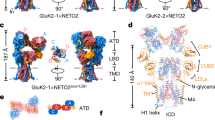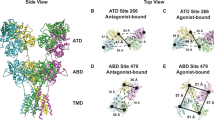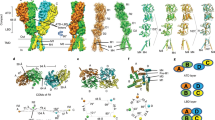Abstract
KAINATE receptors mediate some of the excitatory transactions carried out in the central nervous system by the neurotransmitter glutamate1. They are involved in neurotoxicity2, possibly in neurodegenerative disorders3 and it has been suggested that they have a role in long-term potentiation4. Kainate receptors are present both on neuronal1 and glial5–7 cell membranes where they regulate the gating of a voltage-independent ion channel8. Nothing is known about their molecular structure. Taking advantage of the unusually high abundance of 3H-kainate binding sites in the chick cerebellum9,10, we have isolated an oligomeric protein that displays a pharmacological profile similar to that of a kainate receptor, and have demonstrated, using the monoclonal antibody IX-50, that this protein is composed of a single polypeptide of Mr 49,000 which harbours the specific kainate recognition site11. The structure of this kainate binding protein (KBP) is also of interest because of its exclusive cerebellar localization on Bergmann glial membrane12 in close proximity to established glutamatergic synapses13. We now report the isolation of the complementary DNA containing the complete coding region of the kainate binding protein. The predicted structure of the mature protein has four putative transmembrane domains with a topology analogous to that found in the superfamily of ligand-gated ion channels14–16. This raises the possibility, that kainate binding protein may form part of an ion channel and may be a subunit of a kainate subtype of glutamate receptor.
This is a preview of subscription content, access via your institution
Access options
Subscribe to this journal
Receive 51 print issues and online access
$199.00 per year
only $3.90 per issue
Buy this article
- Purchase on Springer Link
- Instant access to full article PDF
Prices may be subject to local taxes which are calculated during checkout
Similar content being viewed by others
References
Watkins, J. C. & Evans, R. H. A. Rev. Pharmacol. Tox. 21, 165–204 (1981).
Fuxe, K., Roberts, P. & Schwarcz, R. (eds) Excitotoxins (Plenum, New York, 1983).
Cotman, C. W. & Monaghan, T. Adv. exp. Med. Biol. 203, 237–252 (1986).
Collingridge, L. & Bliss, T. V. P. Trends Neurosci. 10, 288–293 (1987).
Bowman, C. L. & Kimelberg, H. K. Nature 311, 656–659 (1984).
Sontheimer, H., Kettenmann, H., Backus, K. H. & Schachner, M. Glia, 1, 328–336 (1988).
Usowicz, M. M., Gallo, V. & Cull-Candy, S. G. Nature 339, 380–383 (1989).
O'Brien, R. & Fischbach, G. D. J. Neurosci. 6, 3275–3283 (1986).
London, E. D., Klemm, N. & Coyle, J. T. Brain Res. 192, 463–476 (1980).
Henke, H. & Cuenod, M. in Neumtransmitters and Their Receptors (eds Littauer, U. Z. et al.) 373–390 (Wiley, New York, 1980).
Gregor, P., Eshhar, N., Ortega, A. & Teichberg, V. I. EMBO J. 7, 2673–2679 (1988).
Teichberg, V. I. et al. in Excitatory Amino Acids and Neuronal Plasticity (ed. Y. Ben Ari) (Plenum, New York, in the press).
Blackstone, C. D., Supattapone, S. & Snyder, S. H. Proc. natn. Acad. Sci. U.S.A. 86, 4316–4320 (1989).
Numa, S. Harvey Lectures 83, 121–165 (1989).
Schofield, P. et al. Nature 328, 221–227 (1987).
Grenningloh, G. et al. Nature 328, 215–220 (1987).
Hampson, D. R. & Wenthold, R. J. J. biol. Chem. 263, 2500–2505 (1988).
Klein, A. U., Niederoest, B., Winterhalter, K. H., Cuenod, M. & Streit, P. Neurosci. Lett. 95, 359–364 (1988).
Eshhar, N. et al. Brain Res. 476, 57–70 (1989).
Kozak, M. Nucleic Acids Res. 15, 8125–8132 (1987).
Imoto, K. et al. Nature 335, 645–648 (1988).
Leonard, R. J., Labarca, C. G., Charnet, P., Davidson, N. & Lester, H. A. Science 242, 1578–1581 (1988).
Miller, C. Neuron 2, 1195–1205 (1989).
Liman, E. R., Knapp, A. G. & Dowling, J. E. Brain Res. 481, 399–402 (1989).
Maniatis, T., Fritsch, E. F. & Sambrook, J. Molecular Cloning: A Laboratory Manual (Cold Spring Harbor Laboratory, New York, 1984).
Lathe, R. J. molec. Biol. 183, 1–12 (1985).
Meinkoth, J. & Wahl, G. Analyt. Biochem. 138, 267–284 (1984).
Cathala, G. et al. DNA 2, 329–335 (1983).
Huynh, T. V., Young, R. A. & Davis, R. W. in DNA Cloning: A Practical Approach Vol. 1 (ed. Glover, D. M.) 49–78 (IRL, Oxford, 1985).
Sanger, F., Nicklen, S. & Coulson, A. R. Proc. natn Acad. Sci. U.S.A. 74, 5463–5467 (1977).
Kyte, J. & Doolittle, R. F. J. molec. Biol. 157, 105–132 (1982).
Nef, P., Oneyser, C., Alliod, Ch., Couturier, S. & Ballivet, M. EMB0 J. 7, 505–601 (1988).
Author information
Authors and Affiliations
Rights and permissions
About this article
Cite this article
Gregor, P., Mano, I., Maoz, I. et al. Molecular structure of the chick cerebellar kainate-binding subunit of a putative glutamate receptor. Nature 342, 689–692 (1989). https://doi.org/10.1038/342689a0
Received:
Accepted:
Issue Date:
DOI: https://doi.org/10.1038/342689a0
Comments
By submitting a comment you agree to abide by our Terms and Community Guidelines. If you find something abusive or that does not comply with our terms or guidelines please flag it as inappropriate.



